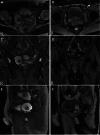Laparoscopic surgery combined with the double-J tube implantation for the rare cystic-solid schwannoma of seminal vesicle: A Case Report and Literature Review
- PMID: 35839059
- PMCID: PMC11132320
- DOI: 10.1097/MD.0000000000029352
Laparoscopic surgery combined with the double-J tube implantation for the rare cystic-solid schwannoma of seminal vesicle: A Case Report and Literature Review
Abstract
Rationale: Schwannoma is common in young and middle-aged people and occurs in the head, neck, posterior mediastinum, and retroperitoneal. Schwannoma, on the other hand, is a rare occurrence in the seminal vesicle. Early diagnosis and treatment are crucial since the disease can cause lower abdominal pain, nocturia, frequent urination, blood sperm, and other symptoms. There is no standard diagnostic or treatment guideline for seminal vesicle schwannomas currently. Therefore, the treatment experience relies on the few cases reported throughout the world.
Patient concerns: A 45-year-old male patient discovered that the tumor beside the right side spermatophore is bigger than 3 years ago.
Diagnosis: Schwannoma of seminal vesicle.
Interventions: Ureter double-J tube implantation and laparoscopic surgery for schwannoma of seminal vesicle.
Outcomes: The operation process went smoothly. And the patient was no discomfort after half a year.
Conclusion: Schwannoma of the seminal vesicle is very rare in the clinic, and the imaging examination was not conclusive. The diagnosis mainly depends on pathological results. Surgical resection is the best treatment method for schwannoma. In surgery for schwannoma of seminal vesicle, combined with the ureter double-J tube implantation are many benefits. This case is an excellent example of the seminal vesicle schwannomas.
Copyright © 2022 the Author(s). Published by Wolters Kluwer Health, Inc.
Conflict of interest statement
The authors have no conflicts of interest to disclose.
Figures





Similar articles
-
Multiple schwannoma of the seminal vesicle: A case report.Medicine (Baltimore). 2020 Aug 14;99(33):e21603. doi: 10.1097/MD.0000000000021603. Medicine (Baltimore). 2020. PMID: 32872015 Free PMC article.
-
Laparoscopic surgery combined with the double J tube implantation for primary seminal vesicle schwannoma: A case report.Asian J Surg. 2023 Aug;46(8):3113-3115. doi: 10.1016/j.asjsur.2023.02.073. Epub 2023 Mar 8. Asian J Surg. 2023. PMID: 36898915 No abstract available.
-
Cystic schwannoma of a seminal vesicle.J Androl. 2012 Sep-Oct;33(5):798-800. doi: 10.2164/jandrol.111.015917. Epub 2012 Feb 23. J Androl. 2012. PMID: 22362077
-
Primary spindle cell sarcoma of the seminal vesicle: A case report and literature review.Andrologia. 2022 May;54(4):e14363. doi: 10.1111/and.14363. Epub 2022 Jan 5. Andrologia. 2022. PMID: 34984692 Review.
-
Malignant solitary fibrous tumor of the seminal vesicle: a case report and review of the literature.BMC Urol. 2025 May 10;25(1):119. doi: 10.1186/s12894-025-01815-6. BMC Urol. 2025. PMID: 40349031 Free PMC article. Review.
Cited by
-
Seminal vesicle schwannoma with chronic hemorrhage.Neurosciences (Riyadh). 2025 Jan;30(1):59-63. doi: 10.17712/nsj.2025.1.20240073. Neurosciences (Riyadh). 2025. PMID: 39800424 Free PMC article.
-
Analysis of Characteristics, Pathogens and Drug Resistance of Urinary Tract Infection Associated with Long-Term Indwelling Double-J Stent.Infect Drug Resist. 2023 Apr 8;16:2089-2096. doi: 10.2147/IDR.S392857. eCollection 2023. Infect Drug Resist. 2023. PMID: 37063938 Free PMC article.
-
Analysis of the incidence and risk factors of fever-related ureteral stent-associated urinary tract infection in pediatric patients: a retrospective study.Transl Pediatr. 2025 Mar 31;14(3):391-399. doi: 10.21037/tp-2024-538. Epub 2025 Mar 26. Transl Pediatr. 2025. PMID: 40225071 Free PMC article.
-
Virulence traits and bacterial interactions within the complex microbial population in urinary double-J catheters.Front Microbiol. 2025 Jul 10;16:1624743. doi: 10.3389/fmicb.2025.1624743. eCollection 2025. Front Microbiol. 2025. PMID: 40708917 Free PMC article.
References
-
- MacCollin M, Chiocca EA, Evas DG, et al. . Diagnostic criteria for schwannomatosis. Neurology. 2005;64:1838–45. - PubMed
-
- Latchamsetty KC, Elterman L, Coogan CL. Schwannoma of a seminal vesicle. Urology. 2002;60:515. - PubMed
-
- Claessens N, Heymans O, Arrese JE, et al. . Cutaneous psammomatous melanotic schwannoma: non-recurrence with surgical excision. Am J Clin Dermatol. 2003;4:799–802. - PubMed
Publication types
MeSH terms
LinkOut - more resources
Full Text Sources

